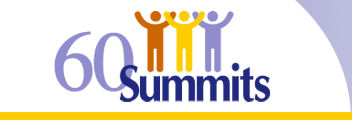
Propagating the new work disability paradigm for disability benefits & workers' comp systems
The 60 Summits Project: Vision of a Stakeholder Summit on Preventing Needless Work Disability
Summary of the idea: In each US state and Canadian province, hold a summit-type meeting of workers' compensation and disability benefits system stakeholders on the topic of the stay-at-work and return-to-work (SAW / RTW) process. Structure the meeting as a one or two day workshop intended to:
- Catalyze on-going action for positive change in the state / province that will:
- improve outcomes of health-related employment disruptions
- prevent needless work disability and promote continued employability
- increase economic productivity and control benefit costs.
- Capitalize on the blueprint for improvement provided by a report from the American College of Occupational and Environmental Medicine (ACOEM) entitled "Preventing Needless Work Disability by Helping People Stay Employed."
- Establish an on-going forum for dialogue and action.
The purposes of each summit meeting are to:
- Create a greater awareness among the stakeholders of the key importance of the SAW / RTW process, its common malfunctions, and the role that each party can play in improving it.
- Provide a workshop in which stakeholders can both speak and listen to one another's point of view.
- Explore the feasibility of implementing the sixteen specific recommendations made in the new ACOEM report, devise strategies to do so, and then identify concrete actions and next steps.
The expected outcomes are:
- Clearer understanding among all the parties that the SAW / RTW process drives outcomes, needs improvement, and is a team effort
- Better working relationships among the stakeholders who must collaborate to make the SAW / RTW process function well
- A multi-stakeholder action group -- a consortium of people who are inspired and willing to do the work required to actualize the consensus agreements, preliminary plans, and commitments that were made in the Summit.
Summit attendees are from all major stakeholder groups: employers, direct healthcare providers (especially treating physicians), workers' compensation and disability insurers and claims payers, managed care companies, policymakers (legislators and regulators), workers, unions, attorneys, etc. Between 75 to 125 attendees is typical.
Summit planning, production, and funding: Summit planning groups consist of individuals from a variety of stakeholder groups who champion and produce their own event. The expenses of producing the Summit are met by registration fees, local sponsor contributions, and as available, grants from The 60 Summits Project.
- Champions make their support for the Summit visible to the public, help raise funds locally to pay for the Summit, actively participate in the meeting itself, and if desired, follow up on the specific agreements made during the Summit.
- Sponsors underwrite the Summit with substantial cash contributions or in-kind donations of commercial goods or services, and receive acknowledgement for doing so. Local organizations will be the major funding source for each Summit. Usually, a number of Summit Champions will also be Sponsors.
- The non-profit 60 Summits Project provides assistance with planning, as well as speakers and facilitators for Summit meetings. Jennifer Christian, MD, MPH, President of Webility Corporation and founder of The 60 Summits Project, led development of the ACOEM report. The 60 Summits Project is not an ACOEM activity.
For more information, go to www.60Summits.org, call 508-358-8096, or email Jennifer.Christian@60Summits.org.